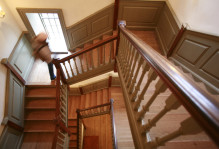Stand-Up Paddle Lessons
Last week, I achieved a goal that has been nagging at my to-do list since I first saw a figure gliding down the James River last summer on a surf-board looking thing: I signed up for a Stand-Up Paddle lesson. After 150 short minutes on the water with a paddle in my hands and a board under my feet, I freely use the acronym, SUP, like I know what I’m doing. I also have seen and appreciated lots of parallels to how SUP relates to my life in general. Please allow me to share.
1) You’re going to fall off your board.
Well, if you’re the other four people in my group SUP lesson, you won’t. But if you’re me, you will fall in. Twice. I was the only kid in my ballet class to be denied pointe shoes when the time came, and those balance issues have followed me to present day. Thing is, if you like being in the water like I do, falling off isn’t so bad – you get to swim! And that stinky life jacket you’re wearing finally has a purpose.
Obvious metaphor here: we all bring our own difficulties and shortcomings to life, and sometimes may get derailed from what we had hoped or expected to do. But the fall can bring a shift, and a chance to show that you have the gumption to get up again. (Even if the instructor has to hang back with you and coach you through it.)
2) When you lose your balance, put your paddle in the water.
When I felt wobbly, I was tempted to use my paddle as a balance bar, as if I were up on the high wire in a sparkly unitard. The counter-intuitive thing about SUP is that putting your paddle in the water and pushing forward even before you fully have your balance helps you find your balance. Sort of like how you accelerate mid-curve while driving a windy road, to help pull you out of it.
It occurred to me that a lot of times, when we’re feeling uncertain about what’s coming up for us, we’re tempted to pull back and brace a bit for whatever may be coming. SUP reminds me that staying in the thick of things and trusting the river to work with you will make it easier to gain your footing.
3) Every once in a while, shift.
Because I had fallen off my board twice already, I was pretty frozen into position once I did gain my balance. It wasn’t until about an hour down the river, though, that I realized how frozen I was. My toes were cramping, all curled up and anxious. Our instructor encouraged us to shift a bit – move this foot forward, this foot to the side. And as much as I doubted my ability to do so while remaining upright, I went for it. Water eased over the side of the board, I swiveled my hips a little, and pushed my paddle back into the classic j-stroke.
Comfort tempts us to settle in to routines and patterns, whether that’s hanging out with the same people, studying the same thing even if it doesn’t really feel like us anymore or thinking about things and other people the same way we always have. Not only is it relieving to let go of something that can be cramp-inducing; it is refreshing to let the water of the shift roll over us as the river proves its trustiness in holding us up.
4) When you have your balance, take your paddle out of the water.
As much as being fully upright on that board made me feel connected to ancient river travel (and maybe made me feel a little bit awesome), my most serene moment on the river was when I took my paddle out of the water. I eased down to a kneel, and then onto my back, stretching the length of my board. My peripheral vision was full from horizon to horizon with water, trees, sky, birds, sky, trees and water again. A couple of huge flocks of Canada geese cut through the muted pastel sunset, and the wind shook the leaves, making the trees look like they had gotten a chill.
For those of us who like to get the most we can out of our little lives, it’s hard not to have our paddles in the water – or our eyes on our to-do lists and our calendars full – all the time. But as someone who can’t resist saying yes to every challenge, I’ve learned in spite of myself that our lives aren’t full if they don’t have some emptiness in them, too. Space to rest, to listen, to let openness bring potential and renewal that would have been overlooked had I not taken my paddle out for a stroke or two.
Comments are currently closed. Comments are closed on all posts older than one year, and for those in our archive.



Melody,
Nice job! Congratulations on your accomplishments! Keep paddling, it gets better.
Thank you for this, Melody. What an incredibly insightful piece. I really appreciate you sharing both your experiences and your observations.